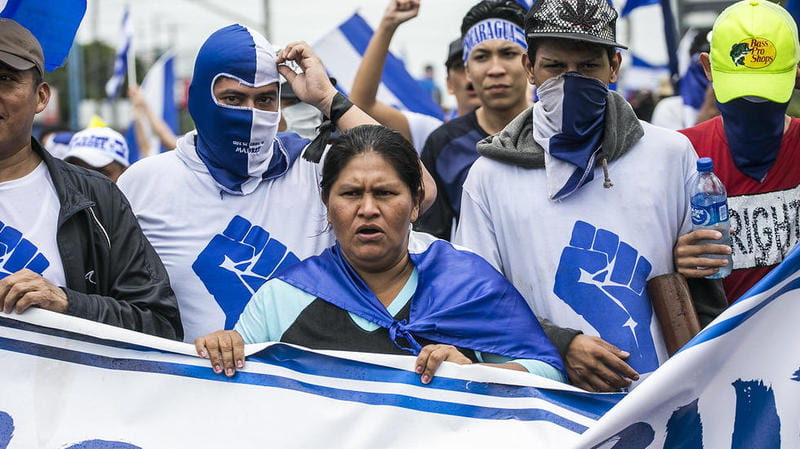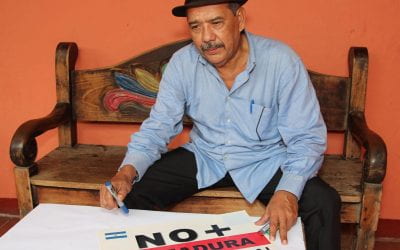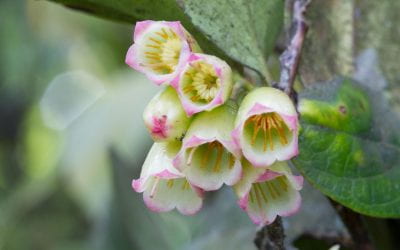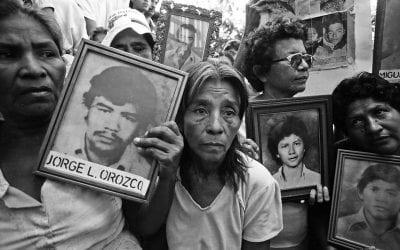Press Freedom Under Siege in Nicaragua Today
Nicaraguans of all walks of life used to fill the reception area of 100% Noticias daily, waiting to speak with the independent news channel’s journalists about how they were being harassed by the police, paramilitary and other government-linked entities.
Since December, the building has been devoid of journalists. Armed police guard the former 100% Noticias headquarters in Managua, and the channel’s leading journalists are in exile. The black-and-red party flag of the Sandinista National Liberation Front now hangs prominently in front of the building.
“They have not returned to us what they have stolen,” said Lucia Pineda, the news director of 100% Noticias, who has been in Costa Rica since she was freed from prison in June. “The Ortega dictatorship is trying to silence us. Daniel Ortega and the Sandinistas have converted into the very thing they once fought against when they mounted the revolution against Somoza.”
Pineda and Miguel Mora, the owners of 100% Noticias, were imprisoned six months, accused of terrorism and “fomenting hate and violence.” They were arrested in December, after defying repeated warnings by the government to stop reporting news critical of the Ortega government. In an increasingly common scenario, police stormed the 100% Noticias offices, arresting Mora, Pineda and others. Mora and Pineda were taken to the notorious El Chipote detention center, described by human rights groups as a torture chamber.
Attacks on the press are at their worst point since the dictatorship of Anastasio Somoza Debayle. Ortega has criminalized journalism. Reporting that puts a spotlight on the shortcomings of government policies is tantamount to treason in the eyes of the authoritarian-leaning Ortega administration. Dozens of journalists have been arrested, most of them charged with incitive and terroristic activity.
To be sure, Ortega began laying the groundwork for the denouement of the press freedom that Violeta Barrios de Chamorro actively supported soon after he returned to power in 2007.
“There was significant media capture by the Ortega government,” said Natalie Southwick, the South and Central America Program coordinator for the Committee to Protect Journalists. “Most of the major television news outlets came to be owned by the government. There was significant control over what they were allowed to report on. There were a few independent news outlets, but even the journalists who worked for them knew where the lines were drawn and how far they could go in their reporting.”
Then came the student-led protests in April 2018, against the Ortega administration’s planned cuts to social security programs. Government security and paramilitary forces clashed with the protesters, succeeding only in prompting the spread of demonstrations on other campuses over the following days, and more protests nationwide for weeks afterward.
The journalists covering the protests became a threat, and a target of the police and paramilitary.
“The regime went full-throttle, using the police, paramilitary, the courts, whatever it could, to repress journalism,” said Pineda, “to silence and attack whomever defied it.”
“They demanded to know why I and my colleagues were reporting the complaints that people who came to our newsroom every day, wanting to tell us about abuse by government officials or supporters of the government, told us,” Pineda said. “They were angry that we were reporting the discontent with the Sandinista government.”
When protests first began last year, she said, “the government sent Sandinista youths after the protesters, they injured the protesters and the journalists, pro-government forces, the paramilitary, stole news cameras, journalists’ cell phones. There was mayhem and violence.”
The government had cable providers cut the signal that was used by independent television stations. They raided the offices and homes of independent journalists.
Journalist Ángel Gahona was killed on April 21, 2018 while covering the unrest following the university protests. Two young men were arrested and charged in his murder, but released during an amnesty this year. Gahona’s family maintains that the two men were scapegoats.
The Chamorro Foundation says the Nicaraguan government has violated press freedom more than 1,000 times since April, 2018. At least 80 journalists have fled the country, with most of them living in exile in Costa Rica. The exiles include Nicaragua’s most prominent journalist, Carlos Fernando Chamorro, editor of El Confidencial, which police raided in December.
“In the face of extreme threats, I’ve had to take the painful decision to go into exile,” Chamorro, who is the son of former President Violeta Chamorro, said in a weekly show he is broadcasting from San Jose. He vowed to “continue to investigate and denounce crimes, corruption and impunity and to document the terminal crisis of this dictatorship.”
Univision correspondent Tifani Roberts, a Nicaraguan-American who has covered Nicaragua since 1985, has been in numerous dangerous situations in various countries while doing her job, but said that seldom has she felt her safety as threatened as it is now by agents of the state.
“There’s hate against journalists by the police in uniform,” Roberts said. “They use foul language against us, they’ll do anything they can to try to stop us, it’s become personal for them.”
“If the police in uniform feel the license to do this to the press, you can just imagine how hostile and violent the paramilitary are, with the impunity they have of the masks they wear.”
Police shot her with rubber bullets when she was covering a protest at a university, leaving her in pain for more than a week, she said. A mob went after her and her cameraman on another day when she was covering a Sandinista event, hurling orange traffic cones at them.
Roberts has documented more than 200 threats from Ortega supporters directed at her through social media since last summer, when she began tracking them.
“They call me an assassin,” she said, “they say ‘You deserve whatever is coming to you,’ and ‘We’re going to rape you.’”
Mora and Pineda spent some time in solitary confinement. Guards denied them their eyeglasses. For a time, Pineda and her cellmates— political prisoners—had no access to a working toilet and were forced to defecate in their hands, she said.
“It was hard, humiliating, dehumanizing,” Pineda said.
“I would ask myself ‘Why am I in jail?’” Pineda said. “’I have committed no crime. I am in jail for the simple act of informing people, for doing my job.’”
Southwick of CPJ said that repression of press freedom in Nicaragua rivals that of Cuba and Venezuela.
“It’s very comparable, in many ways, to Venezuela,” Southwick said of the sweeping censorship, “but it took the better part of a decade in Venezuela. What really struck us as we were covering the crackdown in Nicaragua was the speed—it took place in Nicaragua in the course of just one year.”
The long-time advanced structure of state censorship in Nicaragua provided the springboard for the all-out silencing of the press.
“It was subtle enough until last year so that not everyone outside Nicaragua was aware of it,” Southwick said. “The protests last year drew it out.”
“Reporting, particularly investigative reporting, is viewed as a direct threat to a government that wants to control the narrative, to be the single source of information,” she said.
Like Chamorro, many exiled Nicaraguan journalists are continuing their coverage of the Ortega administration, setting up makeshift newsrooms in living rooms and other shared spaces in Costa Rica.
“The Nicaraguan regime wants to destroy independent journalists, but it’s backfiring,” Pineda said. “Journalists in exile are reinventing themselves with new platforms. If anything, our voices have multiplied. We are finding one another, getting together, brainstorming on new ways to cover Nicaragua.”
Spring/Summer 2019, Volume XVIII, Number 3
Elizabeth Llorente is a journalist whose work has appeared in numerous national and state newspapers and magazines, including The New York Times and Forbes. She was a contributor to the book Authentic Voices: The Best Reporting on Race and Ethnicity and writes regularly about Cuba and Venezuela.
Related Articles
Nicaragua: Editor’s Letter
Someone called out my name in the crowded lobby of Managua’s InterContinental Hotel. I screamed. There was Henry, the young Christian activist from Colombia who left to fight the dictatorship of Anastasio Somoza. Four different people had told me Henry, now known by his…
Botanical Studies in Nicaragua
The mountainous areas of northern Nicaragua finally felt safe enough to roam around after more than forty years of war. What we—two biologists—found was a treasure of unknown and rich plant diversity and beauty where the plants had not been seriously explored for decades…
Blood of Brothers Redux
Tension and long-suppressed anger mingled with shared pain when Nicaraguans who were bitter enemies in the civil war of the 1980s faced each other for the first time in the spring of 2019. Their encounter, at the Watson Institute for International and Public Affairs…





